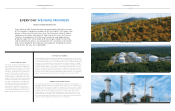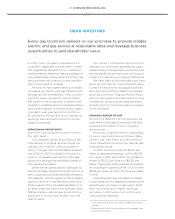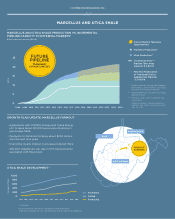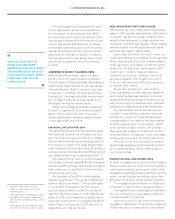Dominion Power 2013 Annual Report Download - page 13
Download and view the complete annual report
Please find page 13 of the 2013 Dominion Power annual report below. You can navigate through the pages in the report by either clicking on the pages listed below, or by using the keyword search tool below to find specific information within the annual report.
15 DOMINION RESOURCES, INC.
the 500-kilovolt loop that serves as the
backbone of our service area and improve
critical substation security.
For the distribution network that serves
homes and businesses, we have targeted
upgrading some of our more vulnerable
infrastructure. We recently completed a
$20 million program to inspect and replace
about 3,000 at-risk transformers, which
reduced the number of transformer failures
by 200 per year in both 2012 and 2013.
And we have developed a $175 million per-
year undergrounding strategy for distribution
system hardening that will help minimize the
eects of severe weather on our customers.
RENEWABLE PORTFOLIO GROWS
Recognizing the need for fuel diversity
and for more renewable resources at Virginia
Power, in late summer 2013 we sought and
won the right to lease more than 100,000
acres o the Virginia coast for a possible wind
farm. Although we are in the early stages
of development, and have not committed
to constructing the project, we are excited
to demonstrate this new technology and
determine the commercial viability of
oshore wind turbines.
In addition, we have ramped up other
renewable energy eorts, placing into service
solar arrays in Connecticut, Georgia and Indiana
and a fuel-cell facility, also in Connecticut.
Together, they represent an investment of
approximately $200 million. Each of these
renewable facilities has long-term, fixed-price
power purchase agreements with electric
cooperatives and utilities in its region.
Over the next two years, we anticipate
growing our fleet of contracted solar projects
by nearly 250 megawatts. Dominion is in
ongoing discussions with multiple parties to
achieve this goal.
NATURAL GAS BUSINESS EXPANSION
For Dominion to reap the benefits of
heftier gas production in the shales of the
Appalachian Basin, we must expand our
current system, build additional facilities
to gather and process that gas, and move
it to market. In the Utica, in particular,
the “wet” gas contains heavy hydrocarbons
known as natural gas liquids (NGL) that
must be extracted before transportation
across interstate pipelines. So processing and
fractionation —separating the NGL into their
component parts for commercial uses —
are essential. As are long-haul pipelines for
transportation, and storage for when supplies
outstrip local demand.
As new players enter the region,
Dominion’s geographic advantage is enhanced
by having constructed and operated such
facilities for 123 years. We have been a
pioneer, building one of the nation’s first
interstate gas pipelines, the nation’s first
extraction and fractionation plant, and one of
the Appalachian Basin’s first underground
storage fields.
Indeed, ours has been a history of
“innovation, ingenuity and accomplishment”—
words spoken in 1979 by one of my
predecessors, former CNG chief Jack
Tankersley — words that continue to be
true today.
PROJECTS OPEN UP NEW MARKETS
From 2014 to 2018, Dominion plans to spend
about $2.1 billion on projects that open up new
markets for gas producers by facilitating their
products’ transportation. In 2013, we also
spent $170 million to replace approximately
203 miles of aged bare steel pipe at
Dominion East Ohio, a steady investment
that will continue for more than a decade.
To support Marcellus production,
in 2013 we brought into service two projects
that move gas to markets or storage in the
Northeast. At a combined cost of $84 million,
the new pipelines and compressor and
metering stations can transport the equivalent
of 362 million cubic feet per day of natural gas
produced in the Marcellus Shale.
Overall, since mid-2012, new DTI pipeline
projects have increased send-out capacities
from Appalachian Basin gas fields by about
1.2 billion cubic feet per day.
In 2014, we intend to bring online new
gas developments that will increase regional
pipeline capacity to move an additional
600 million cubic feet of produced gas per
day— and add 7.5 billion cubic feet of natural
gas storage. Three projects — Allegheny
Storage, Natrium to Market and Western
Access—require approximately $250 million
in capital spending.























